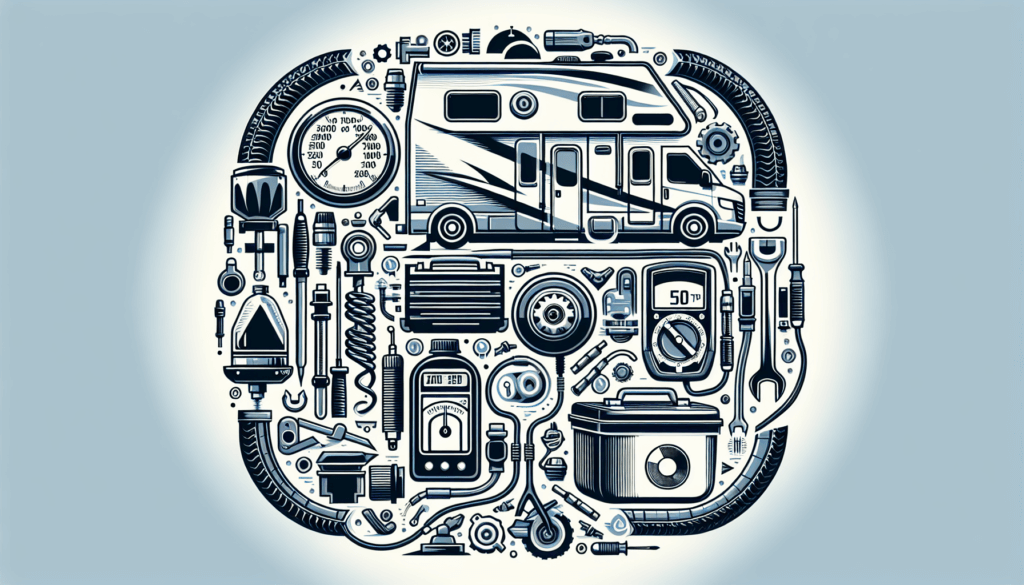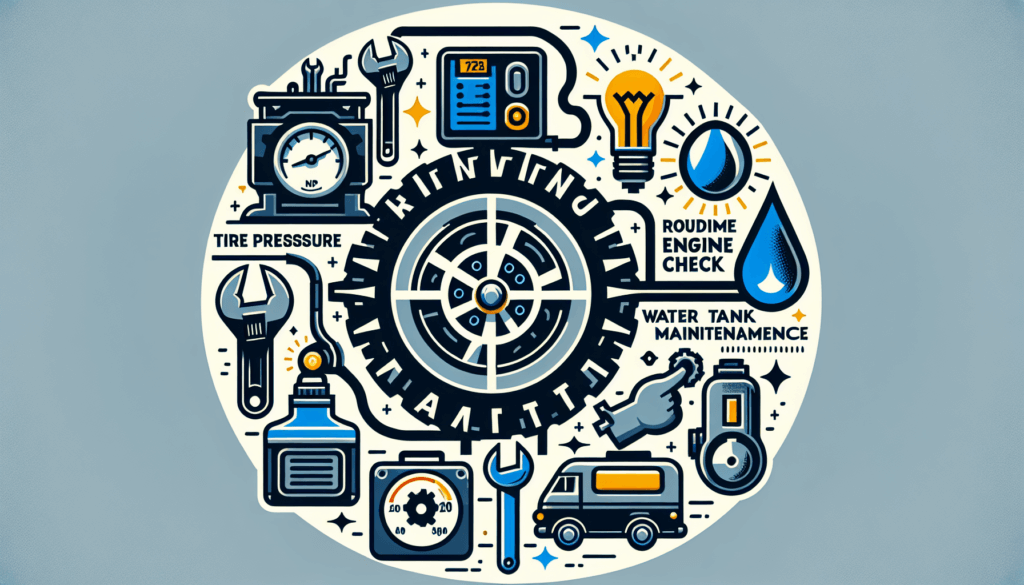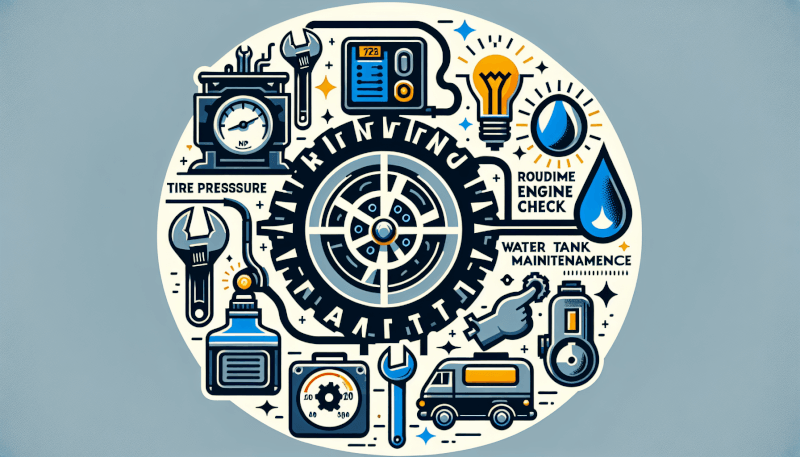Taking care of your RV is crucial for ensuring its longevity and functionality. Whether you’re a seasoned RV owner or a first-timer, following a comprehensive maintenance checklist is essential. From inspecting tires and brakes to checking plumbing and electrical systems, this article will provide you with a user-friendly guide to keep your RV in top shape. So, let’s get started on your journey towards hassle-free adventures and worry-free trips with this must-have RV Maintenance Checklist!
RV Maintenance Checklist
As an RV owner, it’s important to prioritize regular maintenance to keep your vehicle in optimal condition. By taking the time to inspect and care for your RV, you’ll not only extend its lifespan but also ensure a safe and comfortable journey each time you hit the road. This comprehensive RV maintenance checklist covers all the key areas, including exterior, interior, engine, preparation for travel, storage, safety, winterizing, seasonal maintenance, and additional tips. Let’s dive into each section and explore the essential maintenance tasks for your beloved RV.

Exterior Maintenance
Roof
The roof of your RV is one of the most crucial areas to maintain. Regularly inspect it for any cracks, leaks, or signs of damage. You can use a ladder to access the roof and thoroughly examine every inch. If you notice any issues, it’s wise to patch them up immediately to prevent water intrusion and further damage to the interior. Additionally, consider applying a protective sealant to prolong the life of your RV’s roof.
Siding
The siding on your RV not only adds aesthetic appeal but also serves as a protective barrier against the elements. Inspect the siding regularly for any signs of wear, such as peeling, chipping, or fading. If you spot any damages, repair or replace the affected area to maintain the integrity of your RV’s exterior.
Windows
Properly functioning windows are essential for ventilation, natural light, and overall comfort in your RV. Clean the windows regularly, both inside and outside, to ensure clarity and visibility. Inspect the window seals for any gaps or cracks and replace them if necessary. Additionally, lubricate the window frames and hinges to ensure smooth operation.
Seals
The seals on your RV play a vital role in keeping water and moisture out. Inspect the seals around windows, doors, vents, and any other openings for any signs of deterioration or leaks. If you notice any issues, reseal or replace the affected seals to maintain a watertight barrier.
Tires
Proper tire maintenance is crucial for safe travels in your RV. Regularly check the tire pressure using a gauge and ensure they are inflated to the recommended levels. Additionally, inspect the tires for any signs of wear, such as uneven tread or bulges. Rotate and replace the tires as needed to maintain optimal performance and prevent blowouts.
Lights
Ensure all the exterior lights on your RV are in working order. Regularly check the headlights, taillights, brake lights, and turn signals for any burned-out bulbs or wiring issues. Replace any faulty bulbs or repair electrical connections promptly to maintain visibility and comply with traffic laws.
Interior Maintenance
Appliances
Properly functioning appliances are essential for a comfortable journey in your RV. Regularly inspect all the appliances, including the refrigerator, stove, oven, microwave, and HVAC system, for any signs of wear or malfunction. Clean the appliances regularly and ensure they are operating efficiently. If you encounter any issues, consult the user manual or contact a professional technician for repairs.
Plumbing
A well-maintained plumbing system is crucial for your RV’s functionality. Regularly inspect the pipes, faucets, and toilets for any leaks, cracks, or clogs. Ensure the water heater and water pump are in working order. Clean the plumbing system with an appropriate cleaner to remove any buildup. If you notice any plumbing issues, address them promptly to prevent water damage and ensure a smooth water supply.
Electrical System
The electrical system of your RV powers various components, including lights, appliances, and HVAC. Regularly inspect the wiring, outlets, and switches for any loose connections or signs of damage. Test the batteries and ensure they are fully charged. If you encounter any electrical issues, it’s recommended to consult a professional electrician to ensure proper repairs and avoid any safety hazards.
Safety Equipment
Your RV should be equipped with essential safety equipment to protect you and your passengers. Regularly test and replace the batteries in smoke detectors, carbon monoxide detectors, and fire extinguishers. Check the functionality of the emergency escape windows, and ensure they are easily accessible. It’s also advisable to have a fully stocked first aid kit on board for any emergencies.
Furnishings
The furnishings inside your RV contribute to its comfort and functionality. Regularly inspect the upholstery, curtains, blinds, and mattresses for any signs of wear or damage. Clean them regularly and address any necessary repairs promptly. Consider using protective covers to prolong the life of your furnishings and maintain a fresh and inviting interior.
Engine and Mechanical
Engine
The engine is the heart of your RV, and proper maintenance is crucial for optimal performance. Regularly check the oil levels and change the oil as recommended by the manufacturer. Inspect the air filters and replace them when necessary. It’s also important to regularly check the coolant levels, radiator, hoses, and belts for any leaks or signs of wear. Consult a professional mechanic for any engine-related maintenance or repairs.
Fluids
In addition to engine oil, your RV relies on various fluids for proper functionality. Regularly check the transmission fluid, brake fluid, power steering fluid, and coolant levels. Top up or replace the fluids as needed to ensure your RV operates smoothly and efficiently.
Belts and Hoses
Inspect the belts and hoses in your RV’s engine compartment for any signs of damage, cracks, or wear. Replace any worn-out belts or hoses to prevent breakdowns and potential engine damage. Regularly check the tension and condition of the belts to ensure they are functioning properly.
Battery
The battery powers various electrical components in your RV, including lights and electronic devices. Regularly inspect the battery terminals for any corrosion or loose connections. Clean the terminals if necessary and ensure they are tightly secured. Test the battery’s voltage and replace it if it no longer holds a charge. Following proper battery maintenance will help ensure a reliable power source for your RV.
Exhaust System
The exhaust system plays a crucial role in removing harmful gases from your RV’s engine. Regularly inspect the exhaust system for any signs of damage, such as rust or leaks. Ensure the exhaust pipes and muffler are securely attached and functioning properly. Any issues with the exhaust system should be addressed promptly to prevent fumes from entering the RV and risking your safety.

Preparation for Travel
Fuel
Before embarking on a journey, ensure your RV has an adequate fuel supply. Regularly check the fuel levels and plan your refueling stops accordingly. It’s also advisable to keep an emergency fuel container in case of unforeseen circumstances.
Propane
Propane is essential for powering appliances such as the stove, water heater, and refrigerator. Regularly check the propane levels and ensure there are no leaks in the propane system. If you suspect a leak or need to refill your propane tank, consult a professional for a thorough inspection and safe refilling.
Water and Waste Tanks
The water and waste tanks in your RV require regular maintenance to ensure proper functionality and hygiene. Before each trip, thoroughly clean and sanitize the water tanks to prevent the growth of bacteria. Empty and clean the waste tanks regularly to prevent odors and blockages. Additionally, inspect the drain valves and plumbing connections for any leaks or damage.
Supplies
Being prepared with the right supplies is essential for a smooth trip in your RV. Regularly check your supply inventory and restock essential items such as toiletries, cleaning supplies, cooking utensils, bedding, and tools. It’s also advisable to have spare fuses, light bulbs, and batteries on hand for any unexpected situations.
Considerations for Long Trips
If you’re planning a long trip in your RV, there are a few additional considerations to keep in mind. Regularly check the condition of your tires and consider carrying a spare tire. Plan for regular stops to rest, refuel, and stock up on supplies. It’s also important to have a detailed itinerary, emergency contacts, and a backup communication plan. By taking these extra precautions, you’ll ensure a safe and enjoyable long journey in your RV.
Storage
Cleaning
Proper cleaning before storing your RV is essential to prevent the buildup of dirt, mold, and mildew. Thoroughly clean the exterior, including the roof, siding, and windows. Clean the interior, removing all food crumbs and debris. Vacuum or sweep the floors and upholstery, and wipe down all surfaces. By storing your RV in a clean condition, you’ll avoid any unpleasant surprises when it’s time to hit the road again.
Draining Systems
Before storing your RV, it’s essential to properly drain the various systems to prevent damage and odors. Empty and flush out the fresh water tanks, waste tanks, and sewage disposal system. Ensure all valves and connections are securely closed to prevent any leaks. Following these steps will help maintain the cleanliness and functionality of your RV’s plumbing systems.
Checking Appliances
Ensure all appliances are turned off before storing your RV. Thoroughly clean the refrigerator, stove, oven, and microwave. Remove any food and properly dispose of it to avoid attracting pests during storage. Additionally, defrost and clean the freezer to prevent the buildup of ice and odors. By properly maintaining your appliances during storage, you’ll ensure they are in good working order when you’re ready to hit the road again.
Covering and Protecting
Investing in a quality RV cover can go a long way in protecting your vehicle from the elements. Before covering your RV, ensure it is clean and dry to prevent the growth of mold and mildew. Follow the manufacturer’s instructions to properly secure the cover. Additionally, consider using wheel covers to protect the tires and tire covers to prevent sun damage. By properly covering and protecting your RV during storage, you’ll maintain its appearance and prevent potential damage.
Safety
Fire Safety
Fire safety is paramount for any RV owner. Install smoke detectors throughout your RV and regularly test them to ensure they are functioning properly. Place fire extinguishers in easily accessible areas and familiarize yourself with their proper use. Regularly inspect the electrical system and propane system for any potential fire hazards. By prioritizing fire safety, you’ll minimize the risk of fire-related incidents.
Carbon Monoxide Safety
Carbon monoxide is a silent killer that can easily accumulate in enclosed spaces, including RVs. Install carbon monoxide detectors in your RV and regularly test them to ensure they are in working order. Never run the generator or any fuel-burning appliances inside the RV. Proper ventilation is crucial, so ensure vents and windows are open when using propane-powered appliances. By prioritizing carbon monoxide safety, you’ll protect yourself and your passengers from this deadly gas.
Emergency Exits
Knowing the locations and functionality of emergency exits in your RV is vital for your safety. Regularly inspect the emergency exits, including windows and doors, to ensure they open and close smoothly. Remove any obstructions that could hinder a quick evacuation. Create an emergency evacuation plan and practice it regularly with your passengers. By being prepared for emergencies, you’ll be able to handle them calmly and efficiently.
First Aid Kit
A well-stocked first aid kit is a must-have for any RV owner. Regularly check the contents of your first aid kit and replace any expired or depleted items. Ensure the kit contains essentials such as bandages, antiseptic solutions, pain relievers, insect repellent, and any necessary prescription medications. Familiarize yourself with the contents and their proper use. By having a comprehensive first aid kit on board, you’ll be prepared to handle minor injuries or emergencies during your travels.
Winterizing
Water System
Properly winterizing your RV’s water system is essential to prevent freezing and potential damage. Drain all water tanks, including the fresh water tank, waste tanks, and water heater. Open all faucets and ensure no water remains in the pipes. Add RV antifreeze to the plumbing system to protect it from freezing. Consult your RV’s user manual or contact a professional for specific winterizing instructions.
Fuel System
Before winter arrives, it’s important to take proper care of your RV’s fuel system. Add a fuel stabilizer to the gas tank to prevent the fuel from deteriorating over time. Consider topping up the fuel tank to prevent condensation buildup. Additionally, run the engine for a few minutes to circulate the stabilized fuel. By taking these winterizing steps, you’ll ensure your RV’s fuel system remains in good condition during the colder months.
Battery
Properly maintaining your RV’s battery during the winter months is crucial for its longevity. Disconnect the batteries and clean the terminals to prevent any corrosion. Store the batteries in a cool and dry location, away from extreme temperatures. Regularly check the battery voltage and recharge as needed to prevent it from fully depleting. By properly winterizing your batteries, you’ll ensure they are ready for use when the warmer seasons return.
Seals and Windows
To prevent cold air and moisture from entering your RV, it’s important to properly seal all windows and openings. Inspect the seals around windows, doors, hatches, and vents, and replace any damaged seals. Apply a sealant or caulking to reinforce the existing seals and ensure a tight fit. By properly winterizing your RV’s seals and windows, you’ll keep the interior warm and dry during the colder months.
Seasonal Maintenance
Spring Cleaning and Inspections
As winter transitions into spring, it’s time to give your RV a thorough cleaning and inspection. Begin by removing all covers and cleaning the exterior. Inspect the roof, siding, and windows for any signs of damage that may have occurred during the winter. Clean and sanitize the water and waste tanks before refreshing them with clean water. Test all appliances, systems, and safety equipment to ensure they are functioning properly. By completing these spring maintenance tasks, you’ll have a clean and ready-to-use RV for the warmer months ahead.
Summer Cooling Systems
When the temperatures rise, it’s essential to have properly functioning cooling systems in your RV. Regularly clean and inspect the air conditioning unit to ensure it provides efficient cooling. Consider using reflective window coverings or shade to minimize heat buildup inside the RV. If your RV has auxiliary fans, test them to ensure they provide adequate airflow. By maintaining your cooling systems during the summer, you’ll have a comfortable and enjoyable trip, even in the hottest weather.
Fall Comfort and Heating Systems
Preparing your RV for the colder months in fall involves properly maintaining the heating systems for comfort and safety. Test the furnace or heating unit to ensure it operates efficiently. Clean or replace air filters to maximize heating effectiveness. Inspect the ducts and vents for any blockages or leaks. Consider using portable heaters as a supplemental heat source, but ensure they are safe and approved for RV use. By properly maintaining your heating systems in the fall, you’ll stay warm and cozy during your RV travels.
Additional Tips
Routine Checks and Maintenance
In addition to the specific maintenance tasks mentioned above, it’s important to establish a routine for regular checks and maintenance. Set a schedule to inspect your RV every few months, regardless of the season. Check all systems, including electrical, plumbing, and appliances, for any signs of wear or damage. Conduct thorough cleanings, both inside and outside, to keep your RV in pristine condition. By establishing a routine and staying proactive, you’ll catch any minor issues before they become major problems.
Professional Inspections
While regular maintenance tasks can be performed by RV owners, it’s often beneficial to seek professional inspections. Schedule regular appointments with certified RV technicians to conduct comprehensive inspections and address any potential issues. Professional inspections provide peace of mind and ensure that your RV is in proper working order. Consider these inspections as an investment in the longevity and safety of your RV.
Documenting Repairs and Maintenance
Keeping detailed records of all repairs and maintenance tasks performed on your RV is crucial. Maintain a maintenance log that includes dates, descriptions of work completed, and any parts or supplies used. This documentation will help you track your RV’s history, identify recurring issues, and provide valuable information for future owners. Should you decide to sell your RV, a well-documented maintenance log will enhance its value and credibility.
Conclusion
Regular maintenance is the key to a well-functioning, safe, and comfortable RV. By covering all aspects of your vehicle, from the exterior to the interior, engine, preparation for travel, storage, safety, winterizing, seasonal maintenance, and additional tips, you can ensure that your RV is ready for any adventure. Incorporate this comprehensive RV maintenance checklist into your routines and enjoy worry-free travels knowing that you’ve taken care of your beloved home on wheels. Safe travels!


